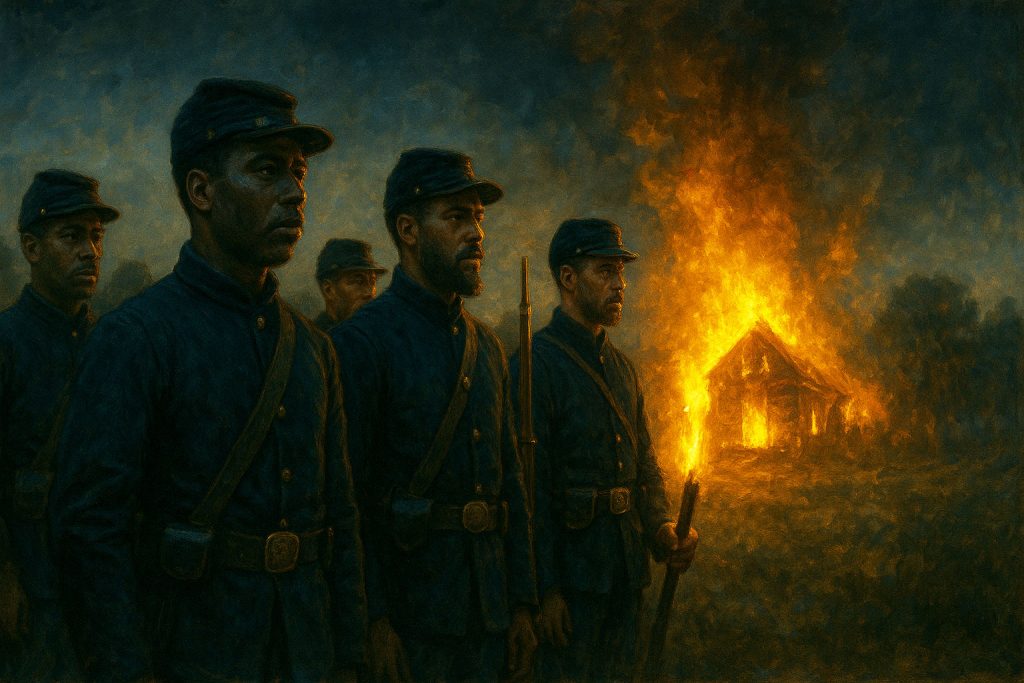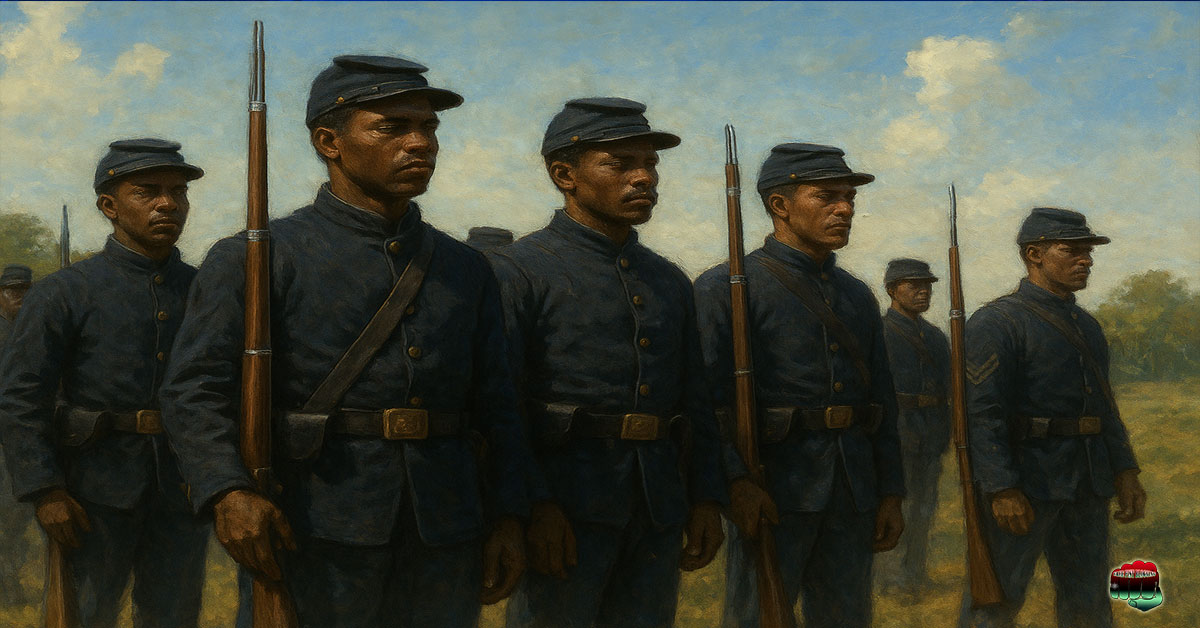By InnerKwest Intelligence Desk | October 19, 2025
The Night the Terror Met Resistance
In the aftermath of the Civil War, the South was burning — not just from defeat, but from the slow, violent unraveling of white supremacy. From the ashes of slavery rose men who had once been forbidden to carry a gun, wear a uniform, or defend their own homes. By 1871, many of them were not only doing those things — they were doing so under the sanction of the United States government.
In the Carolinas, Black militias, made up largely of Union Army veterans and freedmen, began organizing to defend their communities against Ku Klux Klan terror. The Klan’s campaign of midnight whippings, lynchings, and arson was intended to crush Reconstruction and reimpose white political control. But what the Klan had not counted on was that some freedmen had already tasted organized military power — and they weren’t about to surrender that power quietly.
President Ulysses S. Grant, himself a former Union general, recognized what was happening: The rebellion had simply changed form. By October 1871, he made one of the boldest decisions of the Reconstruction era — he sent the U.S. Army into South Carolina to work alongside Black militias to dismantle the Klan’s paramilitary network.
For a brief but defining moment, the full force of the United States stood behind Black Americans defending themselves.
Reconstruction’s Militant Undercurrent
Most Americans learn about Reconstruction through a political lens — the amendments, the Freedmen’s Bureau, or the brief rise of Black legislators in the South. But a lesser-known story runs parallel to that history: the armed defense of freedom itself.
Following emancipation, many freedmen who had served in the Union Army returned home with uniforms, discipline, and the confidence of military experience. They organized local militias to protect their communities from re-enslavement and racial terror. These militias were often led by figures like Prince Rivers, Robert Smalls, and James “Jim” Williams — men who were not only veterans, but also symbols of what self-determination looked like for freed Black citizens.
- Prince Rivers, born enslaved in South Carolina, rose through the ranks to become a Union sergeant and later captain in the 1st South Carolina Volunteers (Colored).
- Robert Smalls, who famously commandeered a Confederate ship, The Planter, to freedom, would later serve in Congress — but in the 1860s, he was also a militia leader and recruiter.
- Jim Williams, a freedman and minister in South Carolina, commanded Black militia units that actively patrolled and defended freedmen communities in York County, one of the regions hardest hit by Klan attacks.
These men, and many others like them, represented a quiet revolution: Black people taking up arms under legal authority to secure their liberty.
The Ku Klux Klan’s Counter-Rebellion
The Klan’s rise was no accident. Founded in 1866, the organization spread rapidly through Tennessee, Georgia, and the Carolinas, blending ex-Confederates, former slave patrols, and disaffected white farmers into a shadow army. Its mission was to undo emancipation through terror and intimidation.
By 1870, South Carolina had become ground zero. York, Spartanburg, and Union counties saw waves of night raids: barns burned, teachers beaten, men dragged from their homes and murdered in front of their families. The violence was not random — it was targeted to destroy Black political power. Freedmen who voted, taught, or joined militias were first on the Klan’s list.

When local authorities refused to act, Black militias stepped into the void. Jim Williams’s York County militia was among the most organized. They trained, patrolled at night, and coordinated with state officials to gather intelligence on Klan operations. That defiance made Williams a marked man.
In March 1871, the Klan captured and lynched Williams in front of his congregation. His death became a rallying cry — one that reached all the way to Washington.
Grant’s Decision: October 1871
President Grant had already faced political pressure from Southern Democrats accusing him of “military tyranny.” But reports from South Carolina were impossible to ignore. Congressional investigations revealed mass torture, rape, and murder against freedmen, all aimed at dismantling the Reconstruction governments.
Grant invoked the Enforcement Acts, which had been passed earlier that year to combat voter suppression and white terror. On October 12, 1871, he issued a proclamation declaring nine South Carolina counties in a state of insurrection. The following week, he suspended the writ of habeas corpus — effectively placing the region under martial law.
Federal troops, backed by U.S. marshals and local Black militias, swept through the upcountry. Hundreds of Klan members were arrested. For the first time in American history, the federal government used military power to defend Black citizens’ civil rights.
The operation was a tactical success. The Klan’s infrastructure in South Carolina collapsed within months. Many white supremacists fled, while others turned themselves in. More than 1,000 indictments were issued, and dozens of convictions followed.
A Model of Self-Defense, Not Dependence
This brief episode — Black militias cooperating with the U.S. Army to restore order — remains one of the most underreported victories in American history. It demonstrates something often omitted from popular memory: when given resources, training, and the law’s protection, Black Americans didn’t need charity. They needed partnership and legitimacy.
Communities across South Carolina saw a temporary peace that had eluded them for years. Freedmen could farm without fear. Schools reopened. Black political participation surged. This stability wasn’t born of benevolence — it was secured through organized, disciplined, armed resistance backed by the state.
But the victory was fragile. After 1877, federal troops were withdrawn under the Compromise that ended Reconstruction. White supremacist “Redeemer” governments returned to power, and Black militias were outlawed. Within a decade, Jim Crow had erased much of what the Reconstruction militias had fought for.
Still, for a time, the freedmen had proven the core truth of citizenship: protection and participation go hand in hand.
The Men Who Led the Resistance
Prince Rivers: The Sergeant Who Became a Statesman
Prince Rivers’s rise from slavery to captaincy exemplified what Reconstruction could achieve. As commander of the Beaufort militia, he not only maintained order but also negotiated with state officials for resources. He later became a delegate to the South Carolina constitutional convention of 1868 and served as a magistrate and state legislator. Though later marginalized by racist backlash, Rivers’s leadership inspired a generation of Black military organization.
Robert Smalls: The Man Who Stole a Ship and a Movement
Smalls’s daring escape from Charleston Harbor in 1862 made him a national hero, but his political and militia work after the war was equally vital. As a militia officer and politician, Smalls advocated for defense funding for Black communities, arguing that freedom without protection was hollow. He understood that the right to bear arms was not abstract — it was a survival necessity.
Jim Williams: The Martyr of York County
Williams’s lynching in 1871 was a turning point that galvanized federal intervention. His disciplined militia had been one of the first organized Black defense units to confront the Klan directly. His death underscored the stakes of self-defense and exposed the depth of Klan infiltration in local law enforcement.
Reconstruction’s Unfinished Business
In hindsight, the events of 1871 illuminate a recurring American pattern: moments when Black autonomy flourished were often followed by violent suppression. Yet these same moments reveal that collective power — especially organized defense — was never beyond reach.
Today, the story of the Black militias of Reconstruction has returned to public conversation as scholars, filmmakers, and activists revisit how African Americans historically protected their communities. It challenges the myth that progress came solely through passive endurance or outside intervention.
These militias were not vigilantes; they were legal citizens operating within state-sanctioned frameworks. They drilled, held ranks, and answered to both Black and white officers under Reconstruction governments. Their existence was a direct rebuttal to the racist narrative that Black self-governance would lead to chaos.
Echoes in Modern America
The question of self-defense versus dependence continues to echo today. Modern social movements often cite Reconstruction militias as evidence that empowerment and protection must be community-led.
From local security groups to neighborhood response teams, the principle remains the same: safety cannot exist without agency. In this sense, Prince Rivers, Robert Smalls, and Jim Williams were early architects of what today might be called “community sovereignty.”
Their militias didn’t just protect Black lives — they defended the legitimacy of Black citizenship itself.
A Legacy of Courage and Clarity
In October 1871, when President Grant sent troops into South Carolina, he didn’t simply crush a domestic terror group — he reaffirmed a radical idea: that the United States would defend all its citizens equally under law. For a fleeting moment, that principle was made real by the cooperation of federal troops and local Black defense units.
That alliance remains a historical anomaly — and a lesson. The freedmen of the Carolinas proved that when armed with structure, law, and purpose, Black communities could not only survive but thrive. The tragedy was not that they failed, but that the nation failed to protect their progress.
Their story endures as a mirror to our present: when trust in institutions falters, organized communities must decide whether to submit to fear or stand together in disciplined defense.
History has already shown what happens when they choose the latter.
Sources:
- Congressional Report on the Ku Klux Klan Hearings (1871–1872)
- Eric Foner, Reconstruction: America’s Unfinished Revolution, 1863–1877
- W.E.B. Du Bois, Black Reconstruction in America
- Leon Litwack, Been in the Storm So Long
- National Archives, Freedmen’s Bureau Records
Support InnerKwest: Powering Truth & Excellence with Bitcoin
At InnerKwest.com, we are committed to delivering impactful journalism, deep insights, and fearless social commentary. Your Bitcoin contributions help us execute with excellence, ensuring we remain independent and continue to amplify voices that matter.
Support our mission—send BTC today!
🔗 Bitcoin Address: 3NM7AAdxxaJ7jUhZ2nyfgcheWkrquvCzRm
Thank you for standing with us in pursuit of truth and progress!![]()

